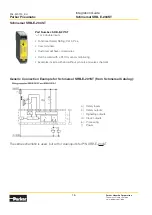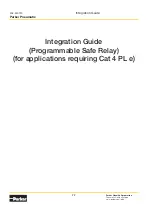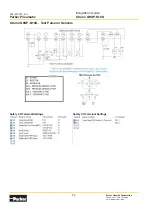
Parker Hannifin Corporation
Pneumatic Division Europe
www.parker.com/pde
9
Integration Guide
P33 Safety Exhaust Valve
FRL-SIF-120
_EU
Parker Pneumatic
Monitoring of the Valve
The P33 valve is equipped with feedback pressure sensors that must be monitored by the user’s external safety
control monitoring system to detect any fault condition within the valve. Sensor feedback should always agree with
the solenoid actuating signals.
Detection of any valve fault should disable the safety control outputs to the valve solenoids and prevent any
subsequent attempts to actuate the valve until a safety control system reset is performed.
Refer to EN ISO13849-1 for cat 3 vs cat 4 monitoring.
Automatic RESET is not recommended by PARKER
Actuation Fault Monitoring
Actuation fault monitoring should check for valve actuation synchronicity. After the safety control system outputs
provide simultaneous actuation signals to both solenoids, both sensor outputs should switch off within 150 msec of
each other. Dependent upon which sensor switches off first, the following faults should be detected.
1. “A” side fault detection – if sensor A does not switch off within 150 msec after sensor B switches off,
this should be registered as a fault.
2. “B” side fault detection – if sensor B does not switch off within 150 msec after sensor A switches off,
this should be registered as a fault.
De-Actuation Fault Monitoring
De-Actuation fault monitoring should check for valve de-actuation synchronicity. After the safety control system
simultaneously remove the actuation signals from both solenoids, both sensor outputs should switch on within 150
msec of each other. Dependent upon which sensor switches on first, the following faults should be detected.
1. “A” side fault detection – sensor A does not switch on within 150 msec after sensor B switches on,
this should be registered as a fault.
2. “B” side fault detection – if sensor B does not switch on within 150 msec after sensor A switches on,
this should be registered as a fault.
Monitoring of Supply Pressure
Loss of Supply Pressure While Actuated
The condition of loss of supply pressure while the valve is actuated must be detected by the safety control monitoring
system. Loss of supply pressure while actuated should cause both sensors to switch on due to lack of pressure in
both valves’ outlet port even though the valve is still energized. This fault can be detected when the solenoids are
high, and one or both sensors go from low (sensing pressure) to high (not sensing pressure).
No Supply Pressure Applied Before Actuation
Monitoring of supply pressure may also be utilized if deemed beneficial for the application but is not required. If you
choose to detect this condition it would require the addition of an upstream pressure switch or transducer. The
condition of the pressure switch or transducer should be monitored to prevent actuation of the valve when supply
pressure is insufficient.
Safety System Reset
Any detected fault in the valve system should cause the safety control system to de-actuate the valve by removing
power from both solenoids. A reset of the safety control system should only be possible after the valve sensors
indicate that the valve is in the de-actuated state (both sensors switched on).


























